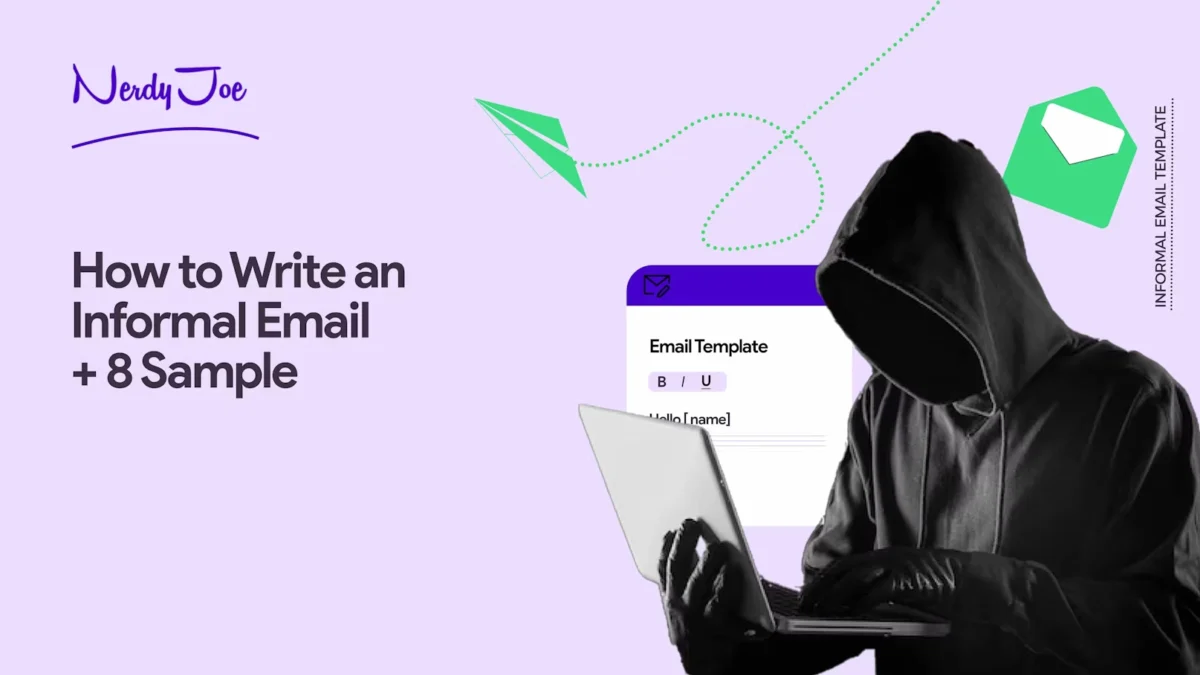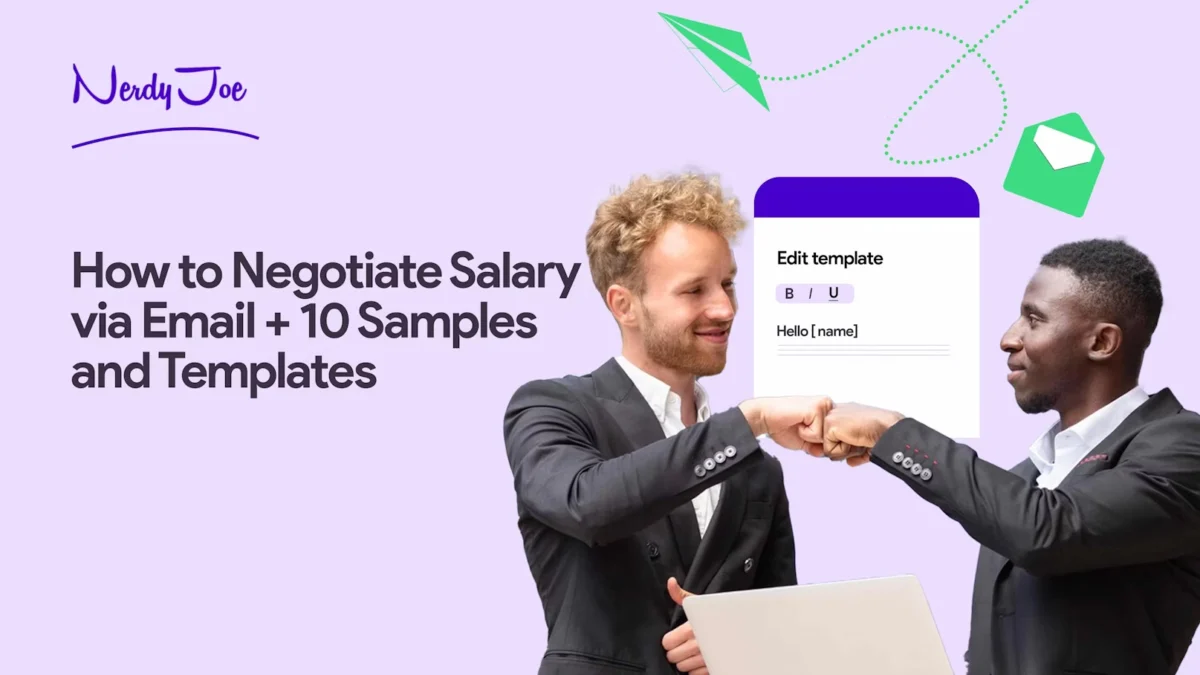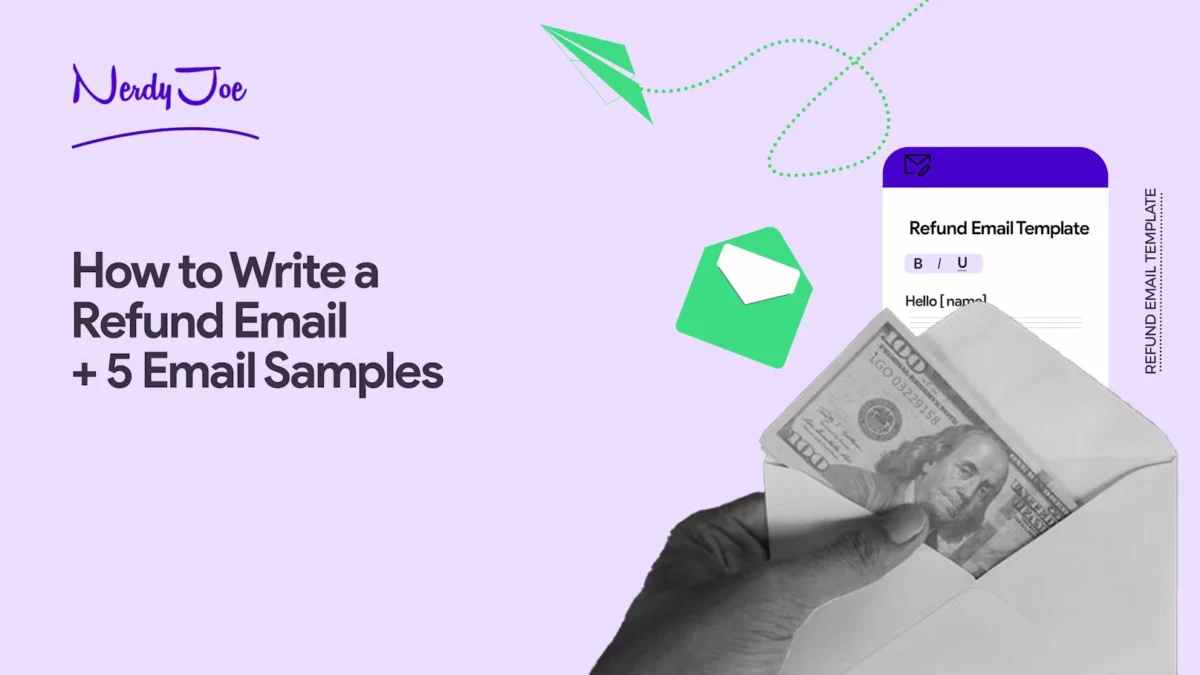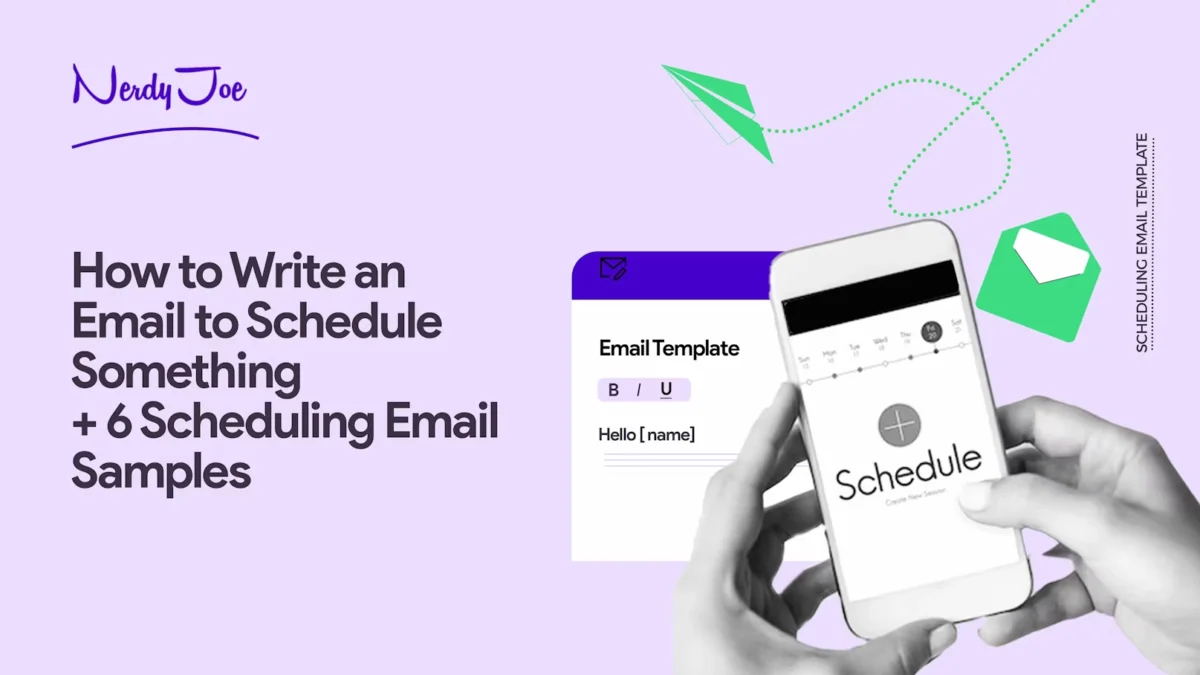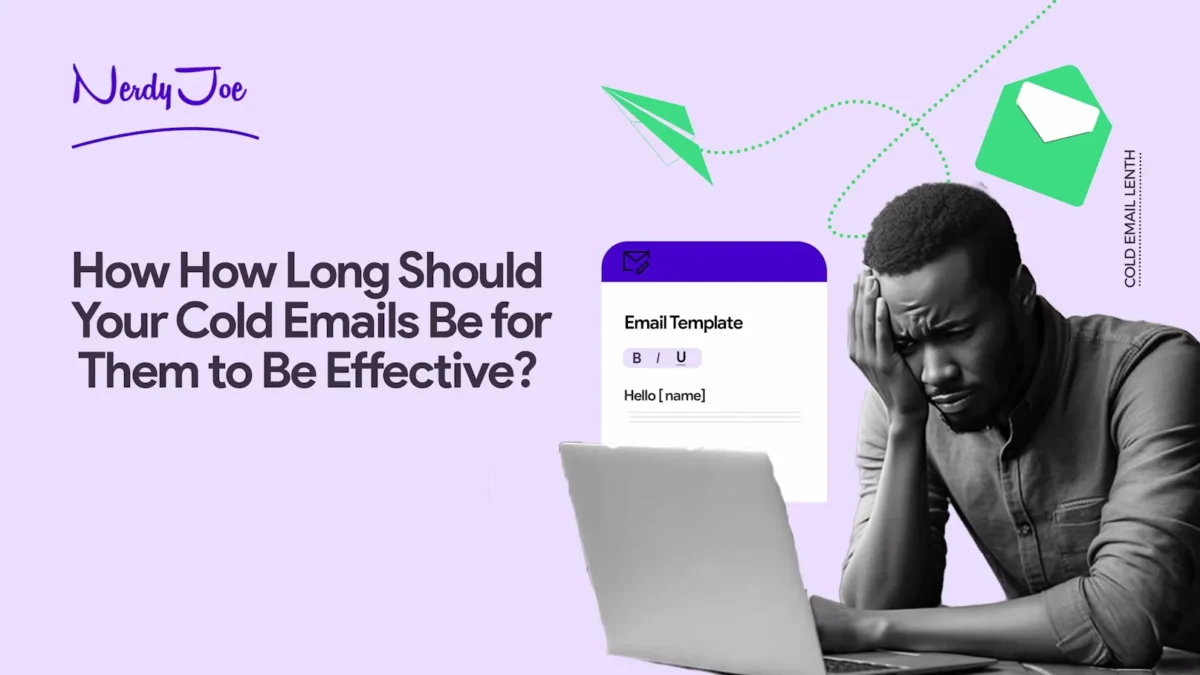What’s B2B Lead Generation And Does It Even Work? [Case Study]
There are many ways B2B businesses can generate leads. Sending cold emails, cold calling, LinkedIn InMail, Twitter outreach, Chabots, online reviews, social media groups, etc.
In fact, we could have made this post about 50 ways B2B businesses can generate more leads. But no.
Instead, we considered the main pain points faced by most companies needing B2B lead generation services — getting more leads and clients — and have realized that only one truly helps businesses generate quality leads, and it’s cold email.
But before we get to that, you might wonder what results we actually get from our cold emails. Well, we do get new leads, qualified leads actually.
Here is how we closed Ross Simmonds, founder of FoundationInc.
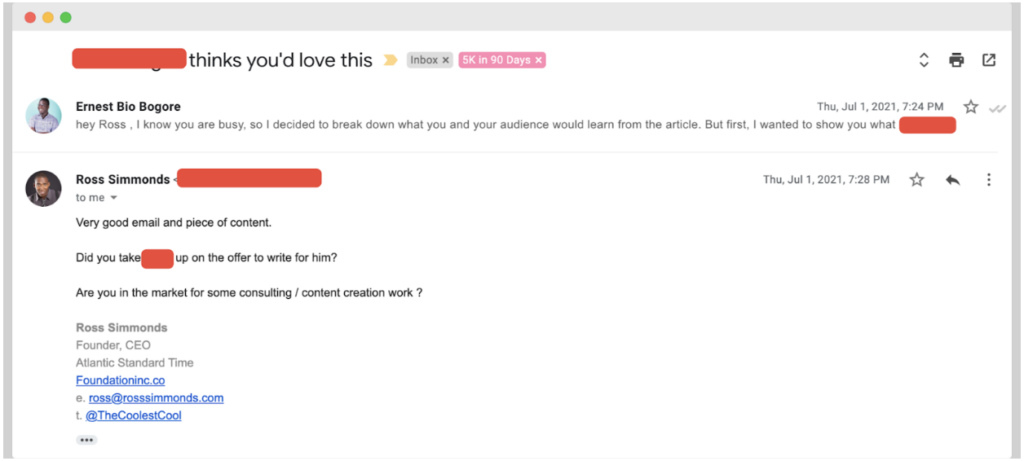
Here is another successful example.

As you can see from both screenshots, the lead generation tactics and the cold emails sent to the prospects were so compelling that they couldn’t help but acknowledge it before offering to hire us.
Before we discuss the steps we follow to generate B2B leads using cold email, let’s first agree on what most people get wrong about B2B leads and why cold email is the best approach to it.
What’s B2B Lead Generation?
B2B lead generation consists of using channels such as inbound and outbound to target people who match your ideal customer profile and who could potentially be interested in your services or products.
What most people get wrong about B2B leads
Quick question.
What do you think it is that both of our prospects from the upper cold email replies have in common?
Guessed it yet?
The answer is simple. They were both ready to buy whatever we were selling after the outreach. Now, that’s what we like to call B2B leads.
Because a company that’s looking for B2B leads is most likely not growing at the rate it wants and is looking to fill its sales pipeline with high-intent, sales-ready leads.
And simply posting online reviews or intrusively cold calling people won’t get you that kind of leads.
Even if it did, it’d take months to convert them, and you will also need other marketing channels and approaches, including email, to eventually win them over.
You need a B2B lead generation strategy that you can truly own, use to educate your prospects, create a product experience, and handle their objections properly. You need an approach that promotes trust and relationships, and cold email is simply the best for it.
Why personalization is your only chance
Here is a little story about us and hyper-personalization.
When we started working in the marketing industry a few years ago, we spent years trying to get high-paying clients for our content marketing agency.
We tried cold email, paid ads, and LinkedIn outreach … none of it worked. Until one day, we tried a different approach.
Instead of sending vague mass emails, we started treating every prospect differently. And as a result, our cold emails were now more personalized and enticing.
We realized that targeting huge prospects lists made it impossible to properly research our prospects and create email copy tailored to their individual traits and touches on their pain points.
Targeting huge lists also came with other issues, such as:
- ESPs and ISPs flagging our email and IP addresses as spammers.
- Killing our company’s reputation (people would say don’t email me again) and getting a bad rap on social media.
- The quality of the leads we had was subpar (the few people that responded were basically stranded)
- Our email deliverability rate was falling.
So, going forward, the approach we championed was basically to make each recipient feel like we know them on a personal level and make them wonder why we didn’t cross their paths months ago.
We no longer wanted to send 1000 cold emails to get four leads. Our ideal scenario is sending 20 well-crafted, super-personalized cold emails, getting 15 replies, ten positives, and getting four sales-qualified leads ready to buy.
Did it work? Heck, yes! Here are a few answers we got from our cold email campaigns.

And here is another where we pitched a Head of Marketing.

We even made a VP of Marketing who historically blocked or reported SPAM to cold email practitioners reply and rock with us.
We got a few more examples from other sales and marketing teams, but you get the idea.
Personalization is how we make people who are averse to cold outreach reply to our cold marketing campaigns and turn them into high quality leads.
Thanks to our new approach, we can now create relatable cold emails that genuinely interest people; we set ourselves apart from others in their mailboxes and easily win deals.
From there, most of the replies we had were something in the realms of:
- “Wow, such a nice email.”
- “Thank you for the nice words and compliment.”
- “Let’s catch up next Thursday.”
- “Love your email. Can you follow up on the 25th?”
Here are the steps we follow to research our prospects and create cold emails that intrigue them and make them buy.
8 steps to creating cold emails that help you generate leads high-intent B2B leads
The following steps are the process we follow to generate qualified leads for our B2B clients. Buckle up; you are in for a treat.
Step 1: Understanding the product and the brand
See, we don’t see B2B lead generation as simply looking up random people online, building a list with their email addresses, and calling it B2B leads.
What we are looking for is to fill our client’s sales pipeline with ready, informed, and high-intent buyers. This process results in boosted sales with very little time in the funnel for our clients.
So, first thing, we don’t start by writing cold emails. Nor do we begin by building a prospect list. We like to start by understanding the prospect’s product and company.
The goal is to thoroughly grasp what you sell and how you wrap it. Next, we seek to understand the company and what matters to it as a brand.
i.e., we’ll ask questions about their missions and overall brand goals. What are things they believe in as an organization and more? Weird, but we do ask them, and it helps to know who they are and how the people they want to sell to will like their brand.
Questions we ask to have a better understanding of the company and offer are:
- What pain point is the product or service selling?
- What situations are the prospects avoiding?
- What happens when they don’t act on that situation?
- Which prospect was the easiest to close?
- Which was the hardest to close?
- What’s their lead-to-close rate?
- What have they done to improve their lead-to-close rate? How did that impact their results?
- Which type of client has the highest lifetime value? Why?
- Which type of client churns the fastest?
The goal is to ensure we fully understand what they offer, how they present it, the audience, how your offer impacts their lifestyle, your competitors, and more.
Step 2: Conducting a situation and market analysis
In most cases, we do this step as part of the upper one. But for the sake of being thorough, I thought it’d be best for your understanding if I separated them.
So, here, building up on the data we collected from learning about your product and brand, we want to know how you are performing right now and what the market situation is projecting for your business.
It’ll help us know how you are doing against your competitors; also, we will be able to learn about your strengths and weaknesses.
Specifically, we are trying to identify the businesses and the potential blockers we are going up against for your product and target audience.
Step 3: Determining ICPs and qualifying them
This step is to determine individuals likely to be interested in the products or services offered. It generally involves research, market segmentation, and persona creation.
But we are not trying to guess it. You are the best person to tell us about your ideal customers. So, here is what generally happens.
Spoiler, most businesses and marketers trying to generate leads get it wrong.
So, basically, we ask the companies we want to generate the leads for who’s your ICP? In most cases, their answers fall somewhere within the following categories:
- Our ICP is SaaS companies
- Our product is directed to eCommerce businesses
- We are targeting tech companies
For some of them, that like to be a little more specific. They come with answers such as:
- Our ICP is a B2B SaaS company that recently had an IPO
- Our ICP is man fashion e-commerce businesses
The thing is, that’s not quality data to run a highly targeted and personalized campaign. So, instead of simply rolling with what they said, we ask a few questions for a more representative perspective of their ICPs.
Here are the questions.
- What’s the story behind your company?
- What type of pain points are you trying to solve?
- What are the top 3 objections from prospective clients during sales calls?
- How do you address these objections?
- Tell us about a time when you worked with a company that fit the criteria, and still, things didn’t go as planned.
- Etc.
We ask questions to understand who they sell to, which type of customers benefit their brand, and which customers we shouldn’t go after.
The answers to these questions help us know precisely who to target and WHY. And this type of information makes the difference between:
“We’re targeting series A tech companies,”
And
“Our ICP is a VP of Sales at a b2b software company selling to HR professionals, and his main pain points are lack of organization, time management, and team collaboration. He often refers to XYZ podcasts to get insights as to how to manage his team efficiently.”
Once we clearly understand who the ICP is, we manually build our list, which we use to run our lead generation campaigns.
Step 4: Manually building a list of leads
You might wonder. Why manually build lists when a simple data intelligence tool such as ZoomInfo with the correct settings can fork out all the necessary data. Well, we do this for a couple of reasons.
- Issue with data accuracy: On the other hand, purchased lists or data intelligence tools may not always provide the level of accuracy and relevance a business requires.
- Poor data quality: We believe in building customer lists manually because it gives complete control over the quality of the data we collect. That’s how we can ensure the information is accurate, up-to-date, and relevant to our client’s needs.
- We want a targeted approach: Manually building our lists allows us to focus on specific criteria that are most relevant to the needs of our customers. It helps ensure we are more effective in our cold email campaigns and obtain better conversion rates.
- Saving you money: While purchasing a list or using a data intelligence tool may seem convenient, it can be expensive. Doing it ourselves is more cost-effective, especially if you run small businesses with limited marketing budgets.
- If it doesn’t comply, we are not using it: Depending on the industry and location, there may be regulations around how customer data can be collected and used. Manually building our outreach lists allows us to ensure compliance with any relevant laws and regulations.
Since we’re already clear on the ICPs and our scoring system, manually building outreach lists becomes easy and fun.
Here is an example of how we keep the prospects in a spreadsheet before the campaign.

Step 5: Researching prospects and creating icebreakers
- We are sending cold emails.
- The prospects know very little about the sender.
- They won’t feel like engaging at all.
If you know a thing or two about cold emailing, chances are you’ve already had a good deal of your outreach emails go unanswered. It’s not unheard of.
That’s because you are going against too many odds when you go unsolicited to a busy person’s inbox for the first time.
And one of the best ways to win your prospects’ attention from the first few lines of your cold email is to break the ice before getting to the subject of the matter. For this, we like to create what we like to call cold email icebreakers.
We research our prospects, personalize our message to the specific reader, and connect with them from the beginning. But there is more to icebreakers than just that.
Here is a cold emailing lesson that we’ve learned over the years:
- Most people always have their guard up when it comes to unsolicited marketing materials in their inboxes.
- For most recipients, your cold emails will feel like just another pitch from a salesperson.
- People don’t like salespeople too much.
Because of that, we strongly believe in having a personalized and persuasive email opening, and that’s what using icebreakers is all about.
Icebreakers help us break up the tedium of marketing by giving the recipient something to chew on or relate to before getting to the point.
How do we do it? I’m so glad you asked.
As we established earlier:
- We don’t use client data when running lead generation or cold email campaigns.
- We don’t rely on data intelligence tools such as ZoomInfo or Lusha.
Part of the reason we don’t trust these data sources is that they only aggregate technographic and demographic data. I mean, you cannot make your prospects feel unique with that data type.
For example, using these tools, it’s easy to find data regarding companies that:
- Are in the accounting software industry,
- Have 30 to 65 employees,
- Are series B-funded companies,
- Are in Europe,
- Use Slack or Digital Ocean as part of their tech stack.
- Have a ping pong table at the office.
Unfortunately, this data can only be used to generate obvious personalized icebreakers like:
“Hey [[First name]],
You’re using Salesforce; let’s hop on a call.
[[Sender name]]”
We don’t want to come across as basic or boring, so we go further down with personalization. Among other types of data, we use psychographic information.
And that’s how we go from
Icebreaker A: I hope this email finds you well. I know your company uses bla bla bla.
to
Icebreaker B: I just watched your interview with Sam Parr, and I love your take on how businesses can double their income by aligning the marketing and sales departments. I, too, believe the best sales happen when marketing and sales teams can get together to discuss customer needs.
Random opening lines simply won’t cut it. Success with icebreakers lies in relevance and details.
So, where do we get information about each prospect or member of your target audience we use for personalization?
Here is how.
- We listen to podcasts your potential customers have been on.
- We read the blog posts they wrote.
- We read their LinkedIn, Twitter, and Mastodon posts.
- We read discussions on forums they’re in.
- We call their mom. I mean, not literally, but yeah.
For the data we collect, we identify unique angles which we can use to craft personalized first lines or icebreakers.
Here’s what it looks like in real life. We pitched CoSchedule’s Head of Content, Ben Sailer, and asked him if we could write for them.
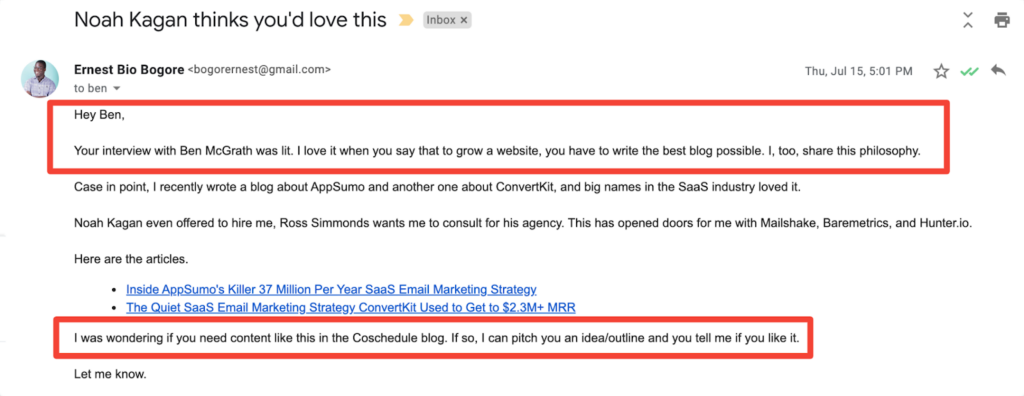
Here’s what he replied 1 hour later.
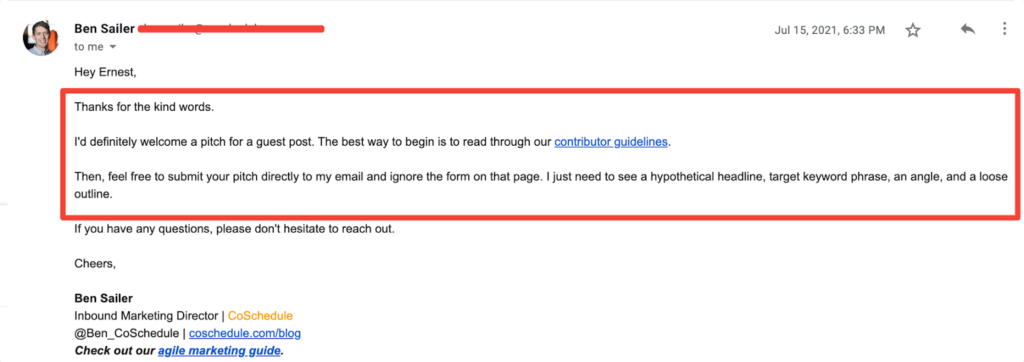
Here is another successful example from a similar strategy.

First, they love the cold emails and tell us they did love them. Then offer to hire us to work with them. Dope!
Note: The icebreakers are also part of the pre-campaign content in our spreadsheets. Here is what it looks like.

Step 6: Creating subject lines
The intruder odds also play against you here. So, from our experience, if someone opens your cold emails, we believe one of the following three scenarios has happened.
- They know you.
- Someone introduced you.
- You caught their attention.
Since we are talking about cold emails and generating B2B leads, the third is where we land.
Creating click-worthy subject lines is a must for the success of our cold emails. It is the first thing the reader sees in the email, so it’s essential to make it compelling. We want to grab the reader’s attention and make them want to open the email.
Ideally, we want something brief, specific, and relevant to the reader. Here are some tips we use for this.
- Personalization: Poorly written subject lines will leave your email unanswered. We like our prospects to know that we specifically researched and targeted them with an offer. You can personalize the subject line with prospects’ first names based on their job title, demographics, software uses, etc.
- Curiosity: Curious people always want to discover and learn more. Doing this helps get the reader excited about what we want to say, and they will likely click. There are many ways you can do this. You can ask an intriguing question. Bring out a relevant fact. The sky’s the limit.
- FOMO: This is all about creating a sense of urgency to get prospects to act rapidly. No one likes to miss out on something valuable. If you do it right, people will click to see what you have to say or offer them.
- Simple: No all caps, no exclamation points (unless you’re asking someone out on a date). These are quick ways to get your emails flagged by spam filters and end up in the junk box.
Step 7: Crafting a compelling, personalized cold email
We told you, we don’t believe in sending many emails to get meager results. Also, we’ve established how personalization is your only chance of winning in this game.
When it comes to writing cold emails, our primary strategy is to make the message about the prospects’ pain points.
We are trying to show them that we are not just blasting them with random emails. We are trying to convince them that our offer is unique and targeted to them.
In our experience, mentioning their paint points makes our cold emails valuable and our offer relevant to them.
So, we consider prospects’ pain points and needs as the starting point. We take a look at the challenges they face and how we can help them. We also consider their business goals or the lifestyle they are chasing and how our service fits into that.
Based on that, we then develop specific use cases of our product or service that will be relevant to them in their unique situation. From there, we proceed to write the value section in your email body as follows:
- Use cases: Unique situations where the offering will be the most meaningful and relatable to the reader. It covers their pain points or aligns with their business or lifestyle goals.
- Benefits: We demonstrate how adopting the offering will impact their life from reading the email body. The value we are bringing to their table or, simply, the lifestyle they will have after integrating the product or using our service.
- Examples: Real-life case scenario of our service in action or how it has done the same for someone with the same need and goals as the prospect.
This approach helps the reader quickly understand the value we are offering and why they should be interested. We like to use bullet points and numbered lists to do this. It’ll also help to make our cold email copy email more readable and easier to scan.
Here’s an example of how we use it to generate more leads. In this cold email, we pitched a Head of Marketing at a B2B Marketing Agency and focused on their specific pain point.

And here’s his reply.

We then ensure the email is well-written and end with a clear call to action. Also, in our books, no two prospects are the same.
We believe every potential customer is different and faces unique challenges. For example, two prospects might need the same tool but not the same features. Because of this, we study each of our prospects and create a unique cold email for everyone.
That’s how we are able to get great results.
Step 8: Sending, tracking, analyzing, and following up
By this time, we already have everything figured out and ready to go. We ensure our copy is compelling, make sure it is the best time to send our cold emails, and then kick off the campaign.
Next, we track and analyze the results to measure our campaign’s success or explain the lack thereof. So, we track email open, positive answers, prospects needing follow-ups, and of course, the deals close — aka conversion.
And for the leads who engaged with our cold emails and showed some interest but didn’t take any action, we follow-up. In most cases, our follow-up process is to handle their potential objections, provide more value about what we are offering, and more.
Finally, we continuously refine the process based on the results we get and how the prospects engage with our campaigns, considering factors such as response, open, and conversion rates.
Why you need to work with Nerdy Joe for your B2B lead generation needs
Here are a couple of reasons you need to work with our agency to generate B2B leads.
Pay for results, not for the number of emails we send
Ask or look around. You’ll find four types of lead generation agencies:
- Those that charge you are based on the number of emails they send or contacts they put in your list.
- Those that charge you a monthly fee and promise you’ll get the best leads ever but never deliver on their promise.
- Those who call everyone who’s downloaded an ebook or PDF a LEAD charge you for that.
- Us that charge based on the number of QUALIFIED leads they generate for your sales team.
Given your needs, you should only care about those who charge based on results. And at Nerdy Joe, we live and breathe client ROI (return on investment).
When we start working with clients, we always make it clear that the prospect list we build and the number of emails we send are not their business.
The number #1 pain point of a company that needs help with lead generation is that they need LEADS. So, we get you leads and charge you for that — not for the work we do.
We only book sales-qualified leads with manually built data.
As we explained, we are crazy about data quality and personalized targeting. Manually building our list is how we ensure that.
It helps ensure that we get qualified leads, and your company won’t have to worry about the cost of data intelligence tools or compliance issues.
Renew or stop your subscription based on satisfaction.
Most people are stuck into 3-6 or 12-month contracts with their lead gen agencies that barely get them any results. It’s costing you a lot of money, you are not getting what you want, and you can’t walk back on the agreement; we feel you.
That’s why we require no contracts. We made our services to be self-serve. You choose what you want; we get it for you. You are happy; we take pride in that, and both parties are satisfied—Bye-bye, long-term contracts and deals.
You know & get exactly what you pay for.
Our offerings and pricing are clear — and this is probably why we’re one of the best outbound lead generation agencies. You choose a plan based on your budget and needs, and you know exactly what you get at the end of the month.
- No, “it depends on a lot of factors.”
- No, “Your account manager swallowed the key to his office and couldn’t work.”
- No “BS”
As long as you have product-market fit and are solving a genuine problem that your ICP has and cares to solve, it is almost everything we need to get you results. But if you’re still figuring out who your solution is best for, then we’re probably not going to help.
Our lead generation service’s pricing is crystal clear. We have three plans:

- Silver: It costs $499/month and only gives you two warm LEADS.
- Gold: This is the plan we recommend, as it gives you the biggest bang for your buck. It costs $999/month and gives you six hot and sales-qualified appointments or LEADS.
- Platinum: This plan is for mid-level to enterprise companies willing to fuel their sales team with up to 15 sales-ready leads every month.
Our pricing also includes the following:
- The tech stack we use to build your prospect list and send and monitor your campaign.
- A complete list of prospects that fit your buyer persona and ICP.
- The campaign setup fees.
Let Nerdy Joe Help You Get B2B Leads
There you have it. We’ve done it for ourselves and many of our clients. You can talk to us here and get a consultation call with us. If you need help with your B2B lead generation strategy, we will gladly help. We’ll be happy to help you.
Here is an overview of the services and perks you can expect from working with us:
- Custom lead generation campaigns.
- We charge you for results, not tasks.
- We won’t require you to commit to a contract.
- We will not waste your time, and we are affordable.
- We care about your company’s reputation and relationship with prospects.
We do the market research, identify leads, do the lead research, lead management, and bring you qualified leads, just like we are part of your team.
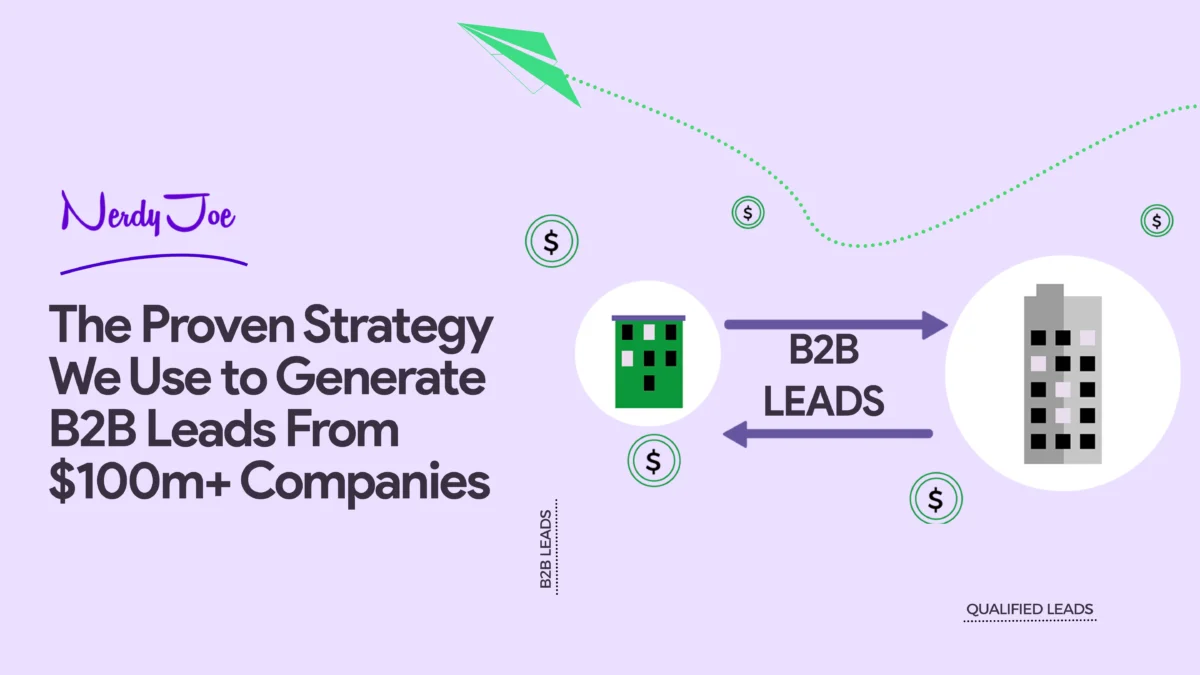
![How to Generate B2B Leads With Cold Outreach [Case Study]](https://nerdyjoe.com/wp-content/uploads/2024/06/1669218674-artboard-1-copie-4-3x-1-1200x675.webp)















